Montane Prism Bootie

The Montane Prism PrimaLoft-filled booties are one of the best camp booties I have used. They are not the warmest booties in my collection, but are warm enough for use in snow and air temperatures down to 10°F or so with a heavy pair of wool socks.
I walked around in them on somewhat rocky and sandy ground in comfort. The Pertex outer shell is very water-repellent, and the synthetic sole stood up well to walking around on rocky soil.
Pros
- Lightweight and compact when packed in the supplied sack
- Warm in moderately cold conditions
- Suitable for walking short distances on most campsite terrain (not for hiking, though)
- Very water repellent
Cons
- Provided stuff sack closure cord failed
- Not suitable for very low temperatures (below 10°F)
- Not suitable for walking in powder snow or slushy snow
Background:
When I (and most climbers, backpackers, and backcountry skiers) get into camp, I like to shed my trail shoes, approach shoes, or boots and put on a pair of booties. This allows my feet to rest from the beating they take from the approach (no matter how comfortable the approach footwear is), and in winter, to stay comfortably warm. This holds whether I am going to sit in my tent or, sometimes in a backcountry log cabin with a roaring fire.
If, as in Antarctica or the Alaska Range, I have to wait out a storm, having warm booties is soothing and more comfortable. If I need to go for a short walk in the middle of the night in the snow, I do not want to have to struggle into my boots. On the other hand, I prefer not to have to carry a heavy pair of camp shoes, although some campsite and weather conditions require it.
Over the years, I have acquired and used a number of pairs of camp shoes, slippers, and booties with more or less insulation (down and synthetic), with and without soles that allowed walking on rocky ground, dirt, mud, and snow, and even just used dry socks for sitting in the tent during a storm. Some have stood up well, though most have proven not very durable. Some have been quite warm (in one case, as warm as my double climbing boots), while others were warm enough only when around the fireplace in a cabin.
As with all the gear I use, I have developed a set of requirements for the “resting in camp” footwear.
- Comfortable
- Warm
- Waterproof (for snow situations or rain)
- Walkable, well-insulated, gripping sole
- Lightweight and compact
I do not expect booties to be a full-on walking shoe, since their primary purpose is to relax my feet after a hard day. However, the “gripping sole” requirement was triggered by an accident on one of the Everest expeditions that appeared on climbing news feeds — at Camp 2, one of the climbers stepped outside his tent in his smooth-soled booties and slipped on the snow. Not having his ice ax in hand (he was nice and safe in camp, after all), he slid at an increasing rate until plunging into a deep crevasse. So I want security when I step outside my tent.
The insulating sole is a requirement mostly in winter when walking on snow or just cold ground. But the insulating sole helps protect the feet against rocks, thorns, and other rough obstacles. Generally, being waterproof means the booties are easy to clean and potentially OK to wear inside my sleeping bag (contrary to those who wear their wet sweaty socks in the sleeping bag, where the moisture gets transported into the sleeping bag’s down).
The following photo shows part of my collection over the years of booties. Most, including some not pictured, have served well, though each has its own quirks. Some of my booties have down fill, while the others have synthetic fibers.
These booties differ widely in their weights. From left to right:
- 180S - 444 gm
- Unlabelled (lost the label somewhere) – 314 gm
- The Montane Prism reviewed in this report – 164 gm, the lightest of my booties
- Montrail liner with removable waterproof outer shell – 315 gm
First Impressions:
When I opened the package, I found the lightweight Montane Prism booties and immediately slipped them on to see about fit. The designated size range is 8 to 10 men’s. Since I wear a size 8.5 to 9.5 shoe or boot size, depending on the manufacturer, I expected, and found that the fit was fairly loose. The same is true of the other three booties in the photo. You don’t really expect a tight or exact fit in a bootie that is intended for relaxing around camp, but you do expect that it will not be so loose that you walk out of them on the one hand, nor do you expect that they will fit tightly and snugly like a sock that is stretchable and your nominal size.
The Montane Prism, unlike most of the others, does have an elastic tightener at the ankle. My initial walks around the house, onto the patio, and up and down the fairly steep stairs showed that the Montanes fit as expected with no excess slippage and no floppiness that would allow walking out of them. While walking around, I did finally notice the adjustable elastic ankle adjustment.
My measured weight for the booties was 5.75 oz/164 grams, consistent with the published weight of 5.8 ounces.
I note that the color of the inset image is yellow, while the supplied sample is black. I have no indication of whether there will be a choice of colors, since the Montane website does not yet include the booties, though they use the "Prism" name on several other products (gloves, etc), indicating this may be a specified group of gear items.
The sole was comfortable with lots of give on the sandstone patio and the quartzite entryway into the house. Since the date of arrival was during a hot spell (by SFBay area standards), I checked the feel of a bare foot on the sandstone vs having the bootie on. Since there was enough insulation to keep my feet somewhat cool (vs taking the booties off and finding the hot stone sent me scurrying for the shaded part of the stonework quickly — unusual for someone who occasionally walks on coals), I concluded that the booties would pass the snow-walk test.
At this point, although finding the soles to provide a good grip on the sandstone and the quartzite, I was suspicious of the gripping on slick surfaces. The following photo shows that the bottom of the sole is dependent on the Hypalon “sticky rubber” composing the sole.
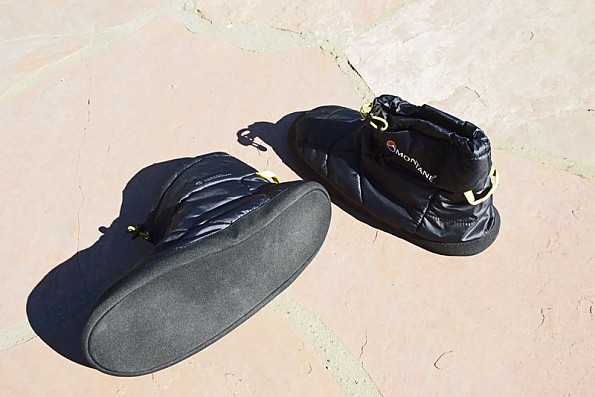
There is some texture to the sole of the Montane Prism. By way of contrast, the “lost label” booties have a heavy cordura cloth sole (making them more of an in-tent bootie), the 180S has a bolder texture semi-sticky rubber sole (which allows a midnight stroll in the snow), and the Montrail’s outer shell has a nobbly structure reminiscent of miniaturized Vibram lugs (which, along with the waterproof outer shell, allows some wandering around a snowy campsite). Whether the Montane’s Hypalon sole is sufficiently grippy will wait until I can get into snow (possibly during my upcoming Asia trip).
Montane claims that their PERTEX Microlite rip-stop nylon outer is durable and water resistant. As a preliminary test, I sprayed the booties with a relatively strong water nozzle setting for several minutes (catching the runoff to pour on our vegetable garden – can’t waste water during our drought, plus the “water police” would issue a citation and fine). As I would expect of Pertex, the water just beaded up and ran off into the bucket. Afterward, I did rub the surface and found a slight wetting out. Again a full test will have to wait.
Details and field testing: Due to the timing of receiving the booties (June 2015) and travel out of the country, I did not get to test the booties in snow. But I did get to wear them under a variety of circumstances that a backpacker or climber will encounter. The photos below show some of the situations of the booties in use.
This photo is of a very typical use for booties, namely when relaxing in a tent. At this point, we were waiting out a thundershower late in the day after getting the tent set up. As you will note, I am not a "glamorous professional model" — my tentmate and spouse decided I needed a photo of me using the booties in a tent and just said "smile", while clicking the flash. My wearing and use of the booties extended over a two and a half month period, serving as my around-the-house slipper/booties as well as in the tent and campsite wear shown in the other photos. The second photo concentrates on the booties themselves.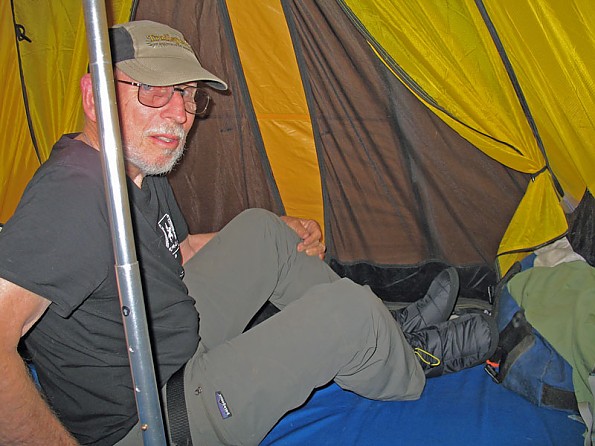
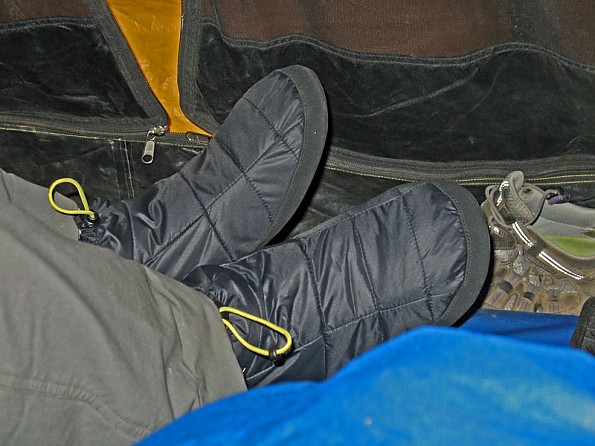
The booties themselves have stood up well, with little perceptible wear during my usage of them. The one failure happened to the storage bag, as shown in the next photo. I was stuffing the booties into the supplied storage bag during our Asia trip. As I pulled the elastic cord to tighten the bag and compress the booties into a very small space, one end of the cord came loose and slid out of the drawstring tube. As can be seen in the photo, the two ends of the elastic were wrapped together in some cloth and stitched together (by hand?).
I suspect that, since this was a pre-release sample, the stitching was done quickly and does not represent the final product. The other Montane gear I have (wind shell and sleeping bag) are finished to a much higher standard. I only included mention of the failure to include my full experience in testing the booties, not because I believe it to represent actual production quality problem. The cuff drawcord on the booties themselves does not even hint at a problem.
The next photo shows the stuff sack with both booties stuffed inside with a ruler to show the compact size and tiny amount of space they would take in an ultralight backpack. Actually, when shoving the storage bag with booties into a pack, it will compress even further.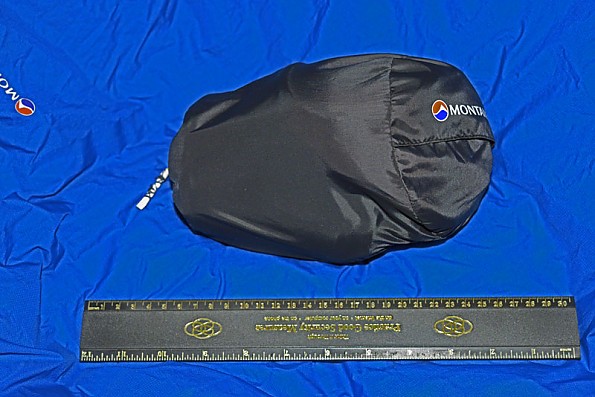
During the time I was testing the booties, I traveled to Japan and Mongolia, doing some climbing (Fuji in Japan, staying at Station 8, sleeping on a shelf with a few dozen other friendly climbers), tent camping in the Gobi Desert (where I spent a bit of time walking around on rocky soil and sand), and the final few days at a ger camp (sleeping in a ger, aka yurt) in a bit of luxury, but walking to the camp’s dining ger through damp grass, thanks to a heavy thunderstorm (yes, the Gobi is a desert at high altitude, hence very dry most of the time, but like deserts everywhere, it does have thunderstorms with lots of lightning and thunder, plus very heavy, though short-lived, “firehose rain”).
I had hoped on my hike up Fuji to have snow (all the photos have snow on Fuji, after all). Unfortunately this year, the snow cover on Fuji was gone. The same was true for the Ice River in Eagle Valley (aka “Yolyn Am), which usually has a large amount of ice year around, home of the “Bearded Eagle”, located in the Gurvan Sayhani nuruu mountains in the south of Mongolia. The following photo was taken at our campsite in these mountains.
Walking in the Steppes of Central Asia near Eagle Valley, wearing the Montane Prism Booties
Temperatures in the Gobi in Eagle Valley, the Singing Sands, and the Flaming Cliffs were fairly cool during the night (rapid drop at sunset into the 30°F range). This allowed for a bit of walking around in the cool of day and on cooled rocky ground in the pre-dawn hours.
During our last few days in Mongolia, we stayed at a ger (aka yurt – the typical Mongolian dwelling) camp, the grass was very wet from the night’s thunderstorm and heavy dew in the morning for the walk to the dining ger, giving a good test of the water repellency of the Pertex shell. Despite the wet grass brushing against the outer shell during the couple hundred meter walk from our ger to the dining ger, the inside of the booties stayed completely dry.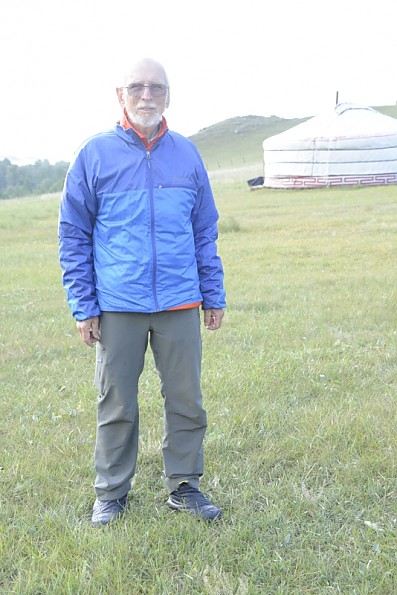
In the ger camp, walking through wet grass to the dining tent in the booties
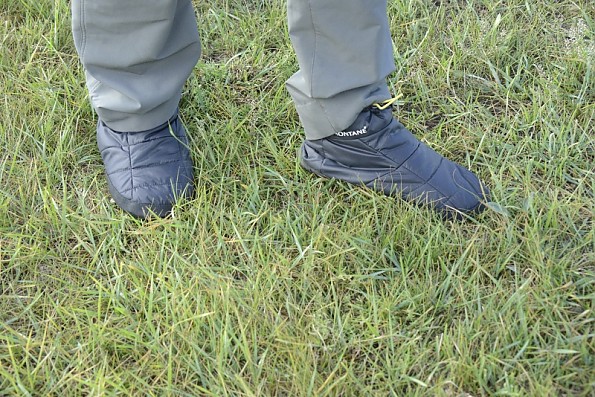
The Pertex shell is water repellent enough to keep the wet grass from soaking through
And, of course, since we did not wear our boots inside the ger, the booties provided comfortable foot cover.
Relaxing in the ger without hiking boots
Summary:
Lightweight, but comfortable, foot covering for use in and around camp is a very desirable thing to have after a day of hiking or climbing, as well as waiting out a storm in the tent. Although we did not encounter any snow storms during the test period, we did spend some time waiting for scattered thunderstorms to die down.
Also, despite the temperatures being warmer than I would have preferred for the test, the booties did keep my feet warm and dry when walking around outside the tent during our low temperatures in the 20-30°F range.
Hopefully, the forecast of a strong El Nino this winter for the Pacific Coast will provide an opportunity for more testing of the booties, at which point I will add an update. All indications in the testing in California, Japan, and Mongolia are that the Montane Prism booties serve their purpose well, and can replace all the collected booties I have in the closet.
Source: received for testing via the Trailspace Review Corps
(Sample provided by Montane for testing and review)
Best camp bootie.
Pros
- Light weight
- Durability
- Warmth
Cons
- ?
Best camp bootie I've used. Have had mine for years. Ultra lightweight with a reinforcement underfoot for camp cooking, chill out at camp. Great fit, packs to nothing. All the warmth I need.
Source: bought it new
Your Review
Where to Buy
You May Like
This practical little bootie is stuffed with 160 grams of Primaloft Gold insulation. It's got a fleecy lining and a durable Hypalon bottom that provides traction, durability and resistance to moisture and chemicals. On the top, a PERTEX Microlite rip-stop nylon outer is coated with a durable water resistant finish to keep your feet dry and toasty. A stuff sack for storage rounds out the package.
- 100% windproof Pertex Microlight rip-stop outer fabric with DWR
- 160g PrimaLoft Gold insulation throughout the bootie upper that is warm, packable and exceptionally fast drying
- PrimaLoft Gold insulation with Grip Control in the inner sole panel to prevent insulation slipping and provide better stability
- Soft brushed microfleece lining that is warm and wicking
- Adjustable ankle for a close, comfortable fit
- Tough Hypalon sole which extends into bootie upper for increased durability
- Stuff sac for storage on the move
Specs
| Price |
MSRP: $55.00 Historic Range: $23.30-$60.00 |
| Weight |
166 g |
| Material |
100% windproof PERTEX QUANTUM Rip-stop outer fabric with DWR |
| Insulation |
160g PrimaLoft GOLD |



